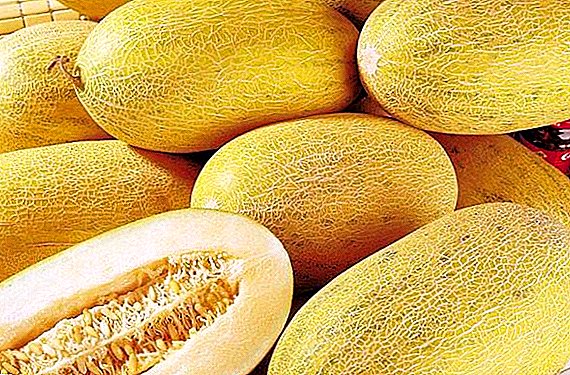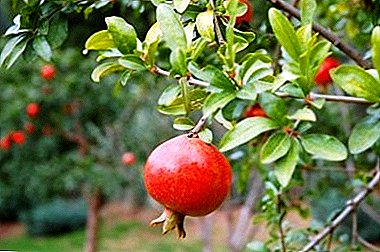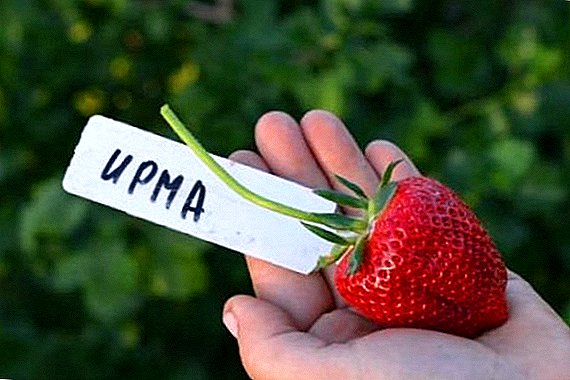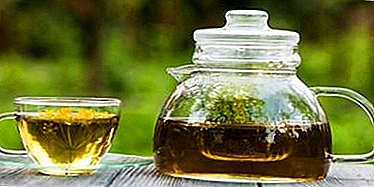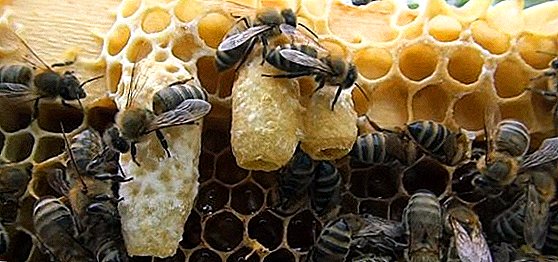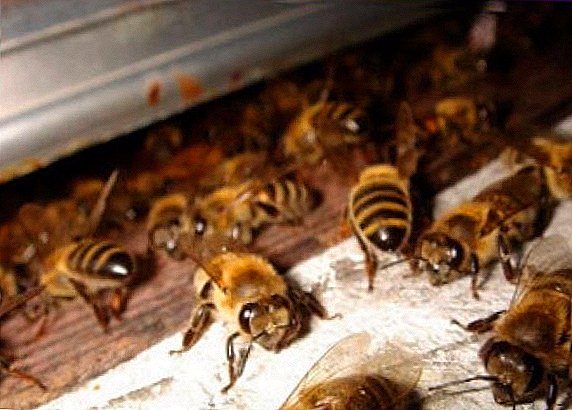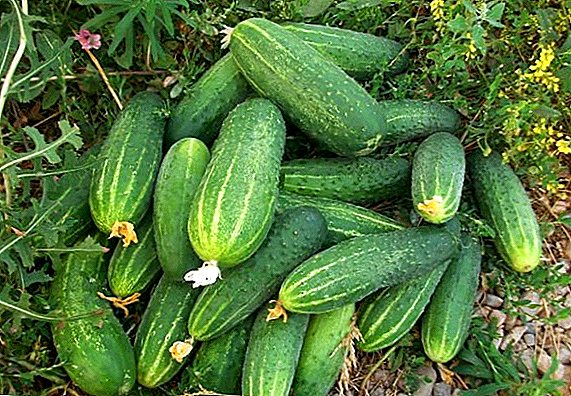 There are beds with cucumbers practically at every site, therefore, due to the popularity of the vegetable, continuous selection work is underway to improve its taste and, of course, to simplify its care. And, as a result, today there is such a variety of varieties on the market that it is easy to get lost in it, especially for beginning gardeners. In this article we will talk about the variety of cucumbers "Phoenix 640", we will deal with its features, advantages and disadvantages, as well as thoroughly and step by step get acquainted with all the nuances of planting and caring for the plant.
There are beds with cucumbers practically at every site, therefore, due to the popularity of the vegetable, continuous selection work is underway to improve its taste and, of course, to simplify its care. And, as a result, today there is such a variety of varieties on the market that it is easy to get lost in it, especially for beginning gardeners. In this article we will talk about the variety of cucumbers "Phoenix 640", we will deal with its features, advantages and disadvantages, as well as thoroughly and step by step get acquainted with all the nuances of planting and caring for the plant.
Variety description
The grade "Phoenix 640" is intended for cultivation in an open ground, belongs to late-ripening. The plant is very tall (up to 3 m in height) bushes and powerful branches. The bush is covered with medium-sized, bright green leaves. Type of flowering - mixed. 
Important! The variety is often confused with its followers, for example, Phoenix F1 and Phoenix Plus, which are hybrids, but Phoenix 640 does not apply to hybrids.
The advantages of these cucumbers include:
- high, stable yield;
- fruits ripen gradually;
- pollinated by bees;
- the universality of the use of fruits and their high taste;
- undemanding to the quality of the soil;
- seeds can be sown both in open ground and on seedlings;
- suitable for transportation and storage.
The disadvantages of the variety are the following:
- tall plants need support;
- require regular dressings;
- crop rotation is of great importance;
- not suitable for growing in a greenhouse.
Check out such cucumber varieties as: "German", "Phoenix Plus", "Siberian Festoon", "Hector", "Crispina", "Taganay", "Lukhovitsky", "Real Colonel", "Masha", "Competitor", "Zozulya", "Finger", "Nezhinsky" and "Courage".
The main distinctive features of the variety are:
- High resistance to diseases and pests.
- The fruits ripen late and gradually, the process lasts until the fall or even the first frost.
- The lack of bitterness in Zelentsev.
Fruit characteristics and yield
The first crop can be harvested 50-60 days after planting, and 1.5-2.5 kg of vegetables per season are harvested from one bush. The cucumbers are distinguished by a cylindrical shape, a bright green color with poorly pronounced light stripes and an average pimple. The weight of greenhouses varies between 150-200 g, and the length of the vegetable can be from 14 to 17 cm.  Fruits "Phoenix 640" can be eaten fresh, as well as used for the preparation of various blanks: pickle, sour, pickle. They have a delicate texture, sweet taste and are covered with elastic, dense skin, which gives the variety universal use possibilities.
Fruits "Phoenix 640" can be eaten fresh, as well as used for the preparation of various blanks: pickle, sour, pickle. They have a delicate texture, sweet taste and are covered with elastic, dense skin, which gives the variety universal use possibilities.
Important! These vegetables crunch pleasantly raw and do not lose their peculiarity when fermented, pickled and pickled.
Selection of seedlings
If you purchase seedlings, but do not grow them yourself, then when buying you should pay attention to the fact that the plant has at least 2-3 true leaves, that is, its age should be 3-4 weeks. Such planting material is considered suitable for landing on the beds.
Soil and fertilizer
Like other cucumbers, "Phoenix 640" prefer light, loose soils with medium acidity. The presence of nutrients, of course, is welcome, and experienced growers recommend preparing the soil for cucumbers in advance, that is, in the fall. Before winter, it is necessary to dig up the area where the crop is planned to be planted, and apply organic fertilizer, manure or compost.  If the land in the beds is not loose enough, it will be useful to add peat, sand or humus in the spring. Compliance with crop rotation is an integral part of high and stable yields. The best predecessors for these cucumbers are solanaceous crops, legumes, carrots, cabbage and onions.
If the land in the beds is not loose enough, it will be useful to add peat, sand or humus in the spring. Compliance with crop rotation is an integral part of high and stable yields. The best predecessors for these cucumbers are solanaceous crops, legumes, carrots, cabbage and onions.
Important! It is recommended to change the location of the beds with cucumbers every 3-4 years, during which time the land is depleted, so the plants are planted elsewhere.
Growing conditions
"Phoenix 640" should be planted in well-lit areas, protected from wind and drafts. Despite the fact that cucumbers love moisture, its stagnation is categorically contraindicated.
Check out the unusual varieties of cucumbers.
Growing from seed to seedlings at home
Cucumber "Phoenix 640" can be sown immediately on the beds, but pre-grown seedlings will significantly save the time it takes to shelter the crops, and will accelerate the growth process, especially in cold regions where the soil warms for a long time. Moreover, the process does not take much time and effort. 
Seed preparation
First of all, it is necessary to disinfect the planting material. To do this, the seeds are placed in a weak solution of potassium permanganate for 15-20 minutes. At the next stage, the seeds are soaked for germination and hardened, if you plan to sow immediately in open ground. For hardening, you must put them in wet gauze and send them in the refrigerator for 3-5 days. Then the seeds are removed and left for several days in wet gauze at room temperature. Planting material for seedlings just need to endure 5-7 days in a damp cloth.
Did you know? 100 g of cucumbers contain only 15 kcal, and the amount of useful substances is very impressive. These vegetables contain water, fiber, vitamins A, B, C, E and K, minerals, and antioxidants. The regular presence of cucumbers in the diet is an excellent prevention of cancer and Alzheimer's disease.
Content and location
Seedlings are grown in separate pots. They must be placed in a well-lit place where the temperature does not fall below +20 ° C. Cold significantly slows down the growth of plants, and very low temperatures can cause their death. 
Seed planting process
Sowing seedlings in containers can be started in early May. Seeds deepen into the substrate by 1-1.5 cm and water abundantly.
Seedling care
Young plants must be watered as the top layer of soil dries. After the appearance of the first leaves, the pots with seedlings must be moved to a cooler and shaded place with an air temperature no higher than +15 ° C, for hardening. After the appearance of 2-3 leaves, the seedlings are ready for planting in open ground.
Important! Experienced gardeners recommend spraying the seedlings on the "Epinay" or "Zircon" leaf the day before the transplant.
Transplanting seedlings to ground
Seedlings are transplanted to the beds in late May-early June, when the probability of night frost is minimal. It is important that by this time the earth is well warmed up, that is, the average daily temperature should be within +15 ° C. Seedlings are planted at a distance of 10-15 cm from each other, and between the rows recede by 40-50 cm. Young plants are recommended to be transplanted to the garden bed together with the earthy clod. The first 7-10 days, it is necessary to slightly shade the young from direct sunlight. 
Agrotechnics growing seeds in open ground
It is very convenient to sow the seeds immediately in open ground, but this process has its own specifics. Let's consider such a variant of planting cucumbers "Phoenix 640" in more detail.
We grow cucumbers in open ground.
Outdoor conditions
The beds for cucumbers in this class should be well lit and protected from wind and drafts. If the sowing of "Phoenix 640" in open ground is carried out in cold regions, then temporary shelter will be needed until the plants get stronger and the thermometers will not fall below the +15 ° C mark even at night. Polyethylene is most often used as a covering material.
The process of planting seeds in the ground
The exact date of sowing can not be called, it is necessary to navigate the weather and air temperature. By the time the cucumbers are planted, the ground should warm up well (at least up to +15 ° C), therefore the end of May and the beginning of June is considered the optimal period.  Pre-germinated seeds are placed in small pits (1-1.5 cm deep) at a distance of 10-15 cm. And if the planting material is not pre-soaked, 2-3 seeds are put in each well. Between the rows, they retreat by 30-40 cm. After the shoots appear, they are thinned out in such a way that 1 square meter. m remained no more than 4 shoots.
Pre-germinated seeds are placed in small pits (1-1.5 cm deep) at a distance of 10-15 cm. And if the planting material is not pre-soaked, 2-3 seeds are put in each well. Between the rows, they retreat by 30-40 cm. After the shoots appear, they are thinned out in such a way that 1 square meter. m remained no more than 4 shoots.
Did you know? If you wipe the mirror in the bathroom with a piece of cucumber before taking a hot shower or bath, it does not sweat.
Watering
Cucumbers "Phoenix 640" are very fond of moisture. Watering plants is recommended as the topsoil dries out, with warm water and only in the evening. In dry weather, it is necessary to mulch the earth around the plants to retain moisture. This can be done with hay, straw, humus or compost.
Soil loosening and weeding
Shallow to loosen the ground every time after carrying out water procedures. And, naturally, the beds with cucumbers should be regularly weeded away from weeds, since such neighbors can take power from the bushes. 
Masking
In order to achieve high yields, the cucumber bush must be formed. After the appearance of the fifth leaf, the main stem is gently pinched, which further allows the development of lateral shoots.
Garter
Due to the fact that the Phoenix 640 bushes are distinguished by their high growth, they need to be supported. This is necessary so that the beds look neat, it is easier to harvest, and also to prevent the occurrence of diseases and pests, because if the stems are lying on the ground, the risk of such problems is very high. The most common and effective way is the garter on the trellis.
Video: trellis for cucumbers
Top dressing
The variety is very responsive to fertilizers, their timely introduction will help to significantly increase the yield. Young plants, i.e., those on which the ovary has not yet formed, are fed every 10-14 days with complex mineral fertilizers. After the formation of ovaries, it is recommended to use organic matter, manure, compost or chicken manure. Organic fertilizers in this period can be alternated with phosphorus-potassium.
Did you know? Cucumbers will help outInsect barrels during a picnic or holiday get-togethers. To do this, cut the vegetables and place them in an aluminum pot, as a result of the reaction that occurs when cucumber juice comes into contact with metal, mosquitoes, midges and flies will fly around the place with such capacity.
Pests, diseases and prevention
The variety "Phoenix 640" is highly resistant to powdery mildew and cucumber mosaic, but may suffer from white and root rot. In the case of these diseases, you should immediately remove the affected areas of the plant and replace the infected soil. The cause of these fungal infections can be stagnant moisture or, conversely, overdried soil.  White rot. Malicious insects infect the shrub very rarely. But still there is a risk of spider mites, as well as melons or sprouts flies. When they are detected, the spray should be “Karbofos” or a solution of tobacco. The main preventive measures to protect the plant from diseases and pests are:
White rot. Malicious insects infect the shrub very rarely. But still there is a risk of spider mites, as well as melons or sprouts flies. When they are detected, the spray should be “Karbofos” or a solution of tobacco. The main preventive measures to protect the plant from diseases and pests are:
- Garter stalks on the trellis.
- Regular soil loosening and weed removal.
- Compliance with the rules of agricultural engineering.
- Spraying infusions of plant origin during the growing season.
- Conduct regular inspection of plants.
Harvesting and storage
The first fruits can be collected within 2 months after planting. Cucumbers need to be removed from the bush very carefully, so as not to damage the plant. The harvest should be collected once in 1-2 days, in this case, the fruits do not re-perepeyut and do not take away the strength and moisture from the bushes, and also do not lose their excellent taste, which is also very important.
Did you know? In order for leather shoes to shine like a new one and not let moisture through, you can wipe its surface with a piece of cucumber.Fruits "Phoenix 640" are suitable for transportation and are well stored for 2 weeks. After harvesting, cucumbers should be washed and dried well, this is very important, as wet fruits will be poorly stored. They are then placed in drawers or plastic containers. Keep them in the refrigerator, pantry or basement. Experienced gardeners sometimes keep Zelentsi in sand, water, damp cloth, or vinegar; these methods allow keeping vegetables fresh for up to 1 month.

Possible problems and recommendations
Improper farming practices can cause the leaves and ovaries to turn yellow and fall off on the plant. This can provoke a surplus of nitrogen, in such situations it is necessary to feed cucumbers with phosphorus-potassium complexes. Causes of foliage and ovary subsidence can also be thickened plantings, improper watering and mechanical damage to the shrub.
Read also what to fertilize, how to keep cucumbers fresh and what to do if the ovaries of cucumbers turn yellow.
Now you know that planting and growing late-ripened cucumbers "Phoenix 640" is very simple. Caring for a crop is reduced to following simple rules, and the great advantage of this variety is resistance to common diseases and pests. It is also worth noting that the greens of this variety have a universal purpose and are used for dining and procurement.


